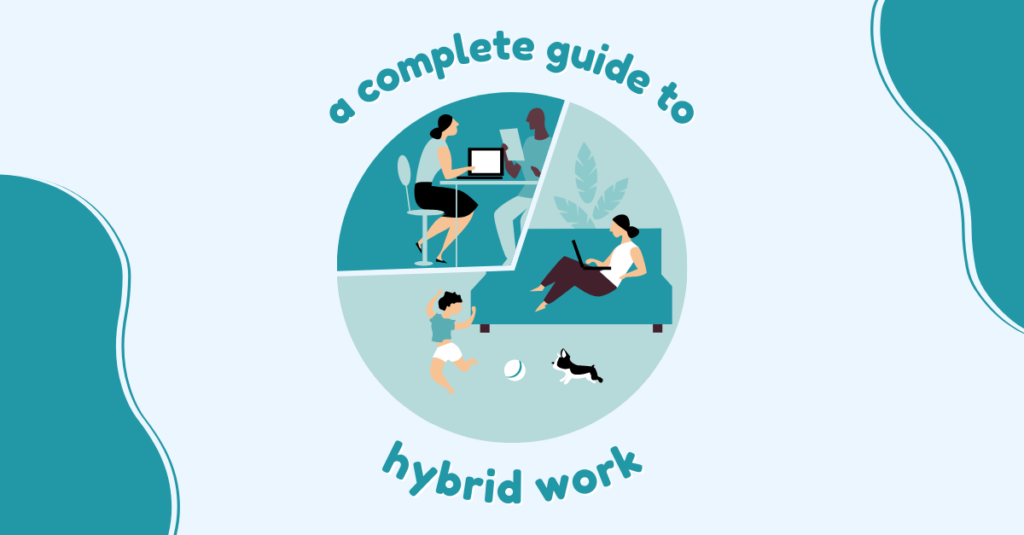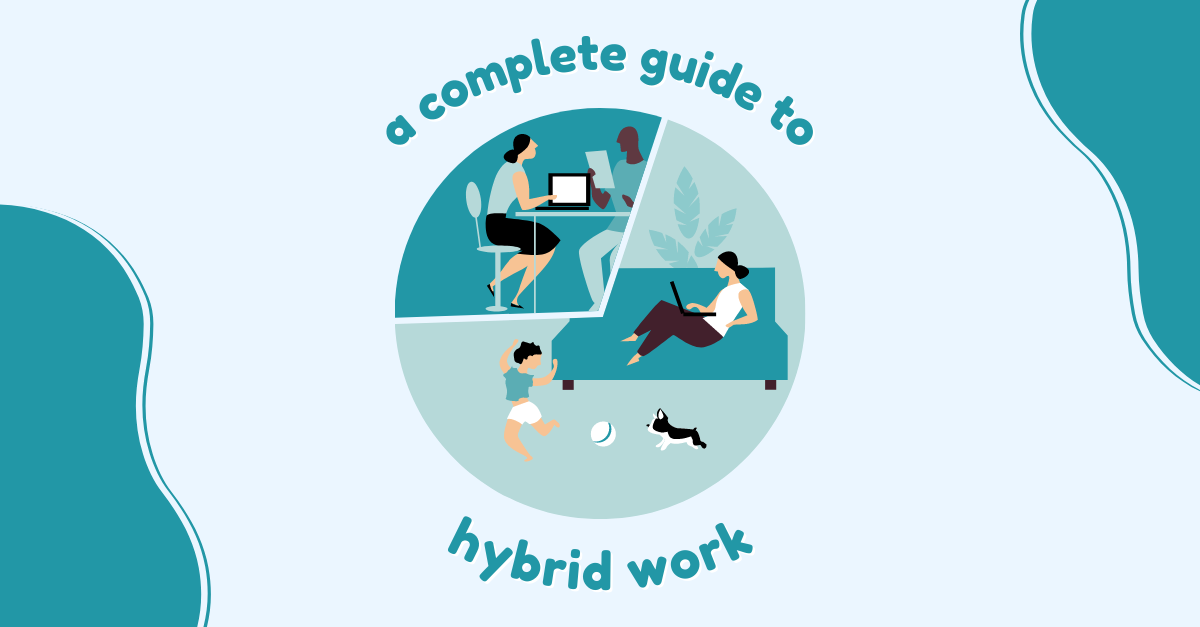The last two years completely transformed the way we work. Flexible work became the norm and many businesses shifted to either fully remote or hybrid work.
And while remote work has been on the rise for many years, hybrid work started to take hold with Covid restrictions lifting.
According to a recent Gallup research on the future of hybrid work, nearly 40% of respondents prefer to work from the office at least 2-3 days per week.
With that number in mind, it’s safe to say that the hybrid work model is currently shaping the world of work.
But what is hybrid work? What does a hybrid workplace look like and what’s the difference between hybrid and remote work?
Let’s find out.
Table of contents
- What’s hybrid work?
- What are the different types of hybrid work?
- What’s a hybrid workplace?
- What’s the difference between hybrid work and remote work?
- Why are companies shifting to hybrid work?
- What are the benefits of hybrid work?
- What are the challenges of hybrid work?
- How to create the best hybrid work environment?
- What’s the future of hybrid work?
- Final thoughts on the hybrid work
What’s hybrid work?
Hybrid work is a combination of remote and on-site work where employees can work partly in the company office and partly remotely.
Hybrid work is perfect for employees who need flexibility in their work schedule and seek a better work-life balance but don’t want to completely give up on office life.
Furthermore, it allows employees to complete their tasks at any time that works best for their schedule.
This blend of remote and office work comes in different shapes – from strictly office-first with occasional work from home to remote-first. So, when it comes to hybrid work, businesses need to choose the best approach that meets their needs.
What are the different types of hybrid work?
There are a few hybrid work approaches that businesses can implement based on their needs and their best working practices.
Office-first with limited remote working
In this hybrid work approach, the company office or HQ is the primary workspace.
While this allows team managers to keep an eye on their employees in the office it doesn’t mean there is no space for flexibility.

Employees are free to work remotely as long as they keep the office as their primary working place and get most of their work done there.
Limitations: This is the weakest form of hybrid work. It is quite possible that workers need more days remotely to consider it a hybrid work model.
Office with generous remote working
In this hybrid work approach, employees can choose when to work from home and when to go to the office.
Companies that implement this remote-ish model believe that their employees will be happier and more productive if they have the autonomy to choose when and where to work.
Employees, on the other hand, embrace the opportunity to split their time between the main office and their home office and it results in better performance.
Remote with occasional office working
This hybrid work approach offers remote work with occasional visits to the office.
Employees are free to work from home when their physical presence is not needed.
However, this model sometimes requires 1-2 days per week spent in the office so employees can join collaboration sessions, training, or team meetings.
Limitations: If your team does not have a rigid schedule for frequenting the office, they start ‘forgetting’ about the office days. If this happens several times, your whole team will get demotivated.
💡Expert tip
Video conferencing tools designed for hybrid teams are a great solution to the problem with the physical presence. Either way, if even one essential team member is gone, you’ll need an appropriate tool.
Remote-first with a limited office working
In this hybrid work approach, the home office is the dominant workspace.
This is the most common type of hybrid work in which employees work mainly from home but are free to visit the office whenever they want.
It’s perfect for virtual teams, working mothers, and employees who prefer to work from home.
The remote-first hybrid approach requires employees to be available for online meetings, collaborations, and training sessions.
There are a bunch of great tools for remote teams that help team managers with anything from scheduling daily check-ins to organizing team meetings.
Expert tip: If you are managing a remote-first team, try to gather your team together at the office (or another location) at least a few times during the year.
Cheers to the epic Christmas parties and occasional pizza Fridays!
What’s a hybrid workplace?
A hybrid workplace is aided by social and communications technology, allowing employees to move freely between offices and remote locations.
The main difference between a traditional and hybrid office space is that the offices in hybrid environments are smaller.

Hybrid workspaces are usually based on hot-desking, meaning no one has a designated desk, and everyone can use any workspace available.
This allows companies to reduce their footprint and gives employees the freedom to work where they want when they want.
Hybrid workplaces, or coworking offices as some people like to call them, are becoming more and more common.
Companies like Microsoft, Spotify, and American Express already started to implement hybrid workspaces for their employees.
What’s the difference between hybrid work and remote work?
The main difference between hybrid and remote work is that a company with hybrid workers has both employees that work remotely and employees that work on-site.
Hybrid employees are usually free to choose which days to spend in the office.
They often follow a hybrid work schedule that ensures everyone gets enough flexibility but is presented in person when needed for collaboration.
Remote companies only have employees that work remotely.
Remote employees all work from home (or another location) without having a main office and often even work from different cities or countries.
Why are companies shifting to hybrid work?
Companies are shifting to hybrid work to reduce costs, improve productivity, and make their employees happier.

Another common reason for companies to turn to hybrid work is the fact that it can be difficult to retain talent.
Not only is the average tenure of an employee increasing, but it’s also becoming more difficult to find and recruit qualified candidates.
This is forcing organizations to rethink their business models and consider hybrid workforces and online workspaces.
However, many organizations don’t have the resources to develop a new workforce from scratch.
Expert tip: If you are one of them, here’s a smart and simple idea for you to implement. Hire full-time employees, freelancers, and contractors. The goal here is to create a well-rounded team that has access to the skills needed for different projects at any given time.
What are the benefits of hybrid work?
The benefits of a hybrid work arrangement are numerous – for both the individual and the company.
From cost reduction to better work-life balance, a hybrid work approach comes with the best of both worlds enabling employees to use their skillset in an efficient and agile manner.
Let’s see what are the best aspects of hybrid work.
Increases productivity
The flexibility of hybrid work allows employees to balance the demands of their roles and responsibilities between home and work.
Numerous pieces of research on the topic show that this freedom significantly increases job satisfaction and productivity.

Moreover, hybrid work has a positive effect on the creativity and motivation of employees.
The ability to set their own schedules and control their workload leads to employees being more engaged in the work they are doing.
In addition, hybrid employees that have a well work-life balance tend to be less stressed out and more productive.
Improves work-life balance
Many people struggle to balance work and personal life.
It can be hard to find time for family and friends, much less get enough sleep or exercise.
At the same time, working long hours in a traditional office environment can be draining.
Hybrid work is perfect for those who want to strike a balance between personal and professional life.
With the hybrid approach, employees can keep their office hours flexible, which might be important at certain points in their careers or life (picking up kids from school or attending important family events).
Reduces commuting
One of the most significant benefits of hybrid work is that it reduces commuting time and pollution.
The average time for a one-way trip to the office in 2019 was approximately 30 minutes.
Instead of spending hours each day commuting, hybrid employees can spend those hours working.
This allows them to better focus on their jobs and also reduces stress, which has a positive effect on productivity.
Cut down expenses
One of the biggest benefits of running a hybrid workforce is the money companies save.
Fewer employees in the office that come with the hybrid work approach means less space required and lower rent costs.
Furthermore, businesses can cut down costs on cleaning services, utilities, and even food.
Companies like Dow Chemical managed to save over 30% on non-real estate costs.
What are the challenges of hybrid work?
Hybrid work empowers employers to incorporate more flexible work models and settings. But this new way of working comes with some challenges too.
Team managers need to find a balance between flexibility and control.
They might also need to adjust their company culture, values, and leadership styles to suit this new way of working.
Here are some of the challenges that hybrid work brings.
Isolation
One of the biggest challenges that face hybrid teams is isolation.
Implementing the hybrid work approach can reduce opportunities for employees to get socialize and that might cause depression and anxiety.

Being disconnected from the rest of the team, even for a short period of time, will make anyone feel more lonely and less productive.
Meeting halfway or having weekly video conferences can help them to stay connected with the rest of the team and alleviate the isolation that comes with remote work.
Communication
Good communication is key to successful teamwork.
Staying in touch with your remote employees may seem tricky but there are many ways to run effective communication and hosting regular virtual meetings is a great start.
Video conferencing is a simple way to gather on-site and remote members of your hybrid team.
There are a bunch of video conference tools that offer 1:1 and group meetings but if you want to take your hybrid workspace to another level, 3veta is what you need for your team.

3veta comes with everything you may need to run your hybrid workforce – Full HD video calls, powerful scheduling features, thousands of other apps to integrate, and more.
Time differences
A common challenge that hybrid teams face is the time difference.
When your team is not around it might be difficult to know when someone is working, or if they’re available for a meeting.
Some people may start their workday at 10 am and finish at 4 pm while others might start their day at 6 am and work till 11 pm.
That’s why having a shared team calendar is a real blessing.
You’ll have a full overview of your hybrid team’s availability and you’ll be able to schedule daily stand-ups, team meetings, project collaboration, and training sessions easily without going back and forth until you find a time that works for everyone.
How to create the best hybrid work environment?
As a business owner or team manager, it’s important to create a working environment that balances the needs of all your employees.
Here are some things to consider in order to create a successful hybrid work experience.
Know your employees’ preferences
The first step before moving to a hybrid work model is to make sure this is what the majority of your employees actually want.
Imagine redesigning the company office to fit the new work model only to find out that most of your employees prefer to work from home (or from their favorite coffee shop).
One famous example is Ian Goodfellow, Apple’s former Director of Machine Learning. When Apple introduced a strict hybrid model with limited remote working possibilities, Ian just quit. Apparently many experts have a strong preference for remote work now and as an employer, you need to take them into account.
Spend enough time with your team and find out what work situation will be best for them.
Some might want to spend 2-4 days in the office while others might want to work from home and limit office visits.
Another thing to consider is finding out what your employees value the most in the workspace.
If you manage a hybrid team, your team members will consist of different personalities and you need to make sure that everyone is heard and given feedback on how to organize work.
Asking your employees about agile working setups, activities, and office parks will help you shape a productive workplace.
Focus on employee well-being and safety
As we mentioned above, happy employees are more productive and more attached to their company.
With that knowledge in mind, focus on providing a safe and healthy office environment.

Small things like installing an air purifier or bringing more natural light might be more valued by your employees than a fitness facility.
For those who prefer staying at home, maybe a new computer may be much more worth it than a new coffee machine at the office.
Ask your employees what they really want and need to feel comfortable.
Don’t forget your employees’ emotional well-being too.
Organize virtual and in-person 1:1 meetings and team buildings and arrange a hybrid work schedule that supports their well-being.
Expert tip: Help your employees to ease their hot desking anxiety by providing a workplace app that indicates which desks are free to use.
This helps employees quickly book a workspace they are comfortable with.
And talking about safety, make sure you educate your employees about cyberattacks and take steps to prevent them to happen.
What’s the future of hybrid work?
The future of hybrid working is looking bright.
As the world changes, so does the workforce and more and more businesses are implementing the hybrid work approach.
Moreover, according to Gallup’s research, when asked where they want to work long-term, about 53% of the employees expect a hybrid work arrangement
With that number in mind, it’s safe to say that hybrid work is not just a trend but it’s here to stay.
Final thoughts on the hybrid work
The workplace is constantly evolving and changing.
Technology is advancing at an exponential rate, and the way we work has been impacted by this change.
One of the biggest shifts in the workforce is adopting hybrid learning and hybrid working.
This has allowed employees to balance the demands of their job and family life, while also earning an income and keeping up with their careers.
There is only one thing to consider before opting for a hybrid work model. As Rami Kaibni, an executive coach at RMK Coaching reminds us, “Hybrid work and the successful implementation of it is highly dependent on the industry”.
Unfortunately, not every team and industry can benefit from hybrid working but if you are seriously considering this transition, 3veta may be right for you.
3veta is the modern meeting experience your hybrid team deserves. Start your free trial today.

























































